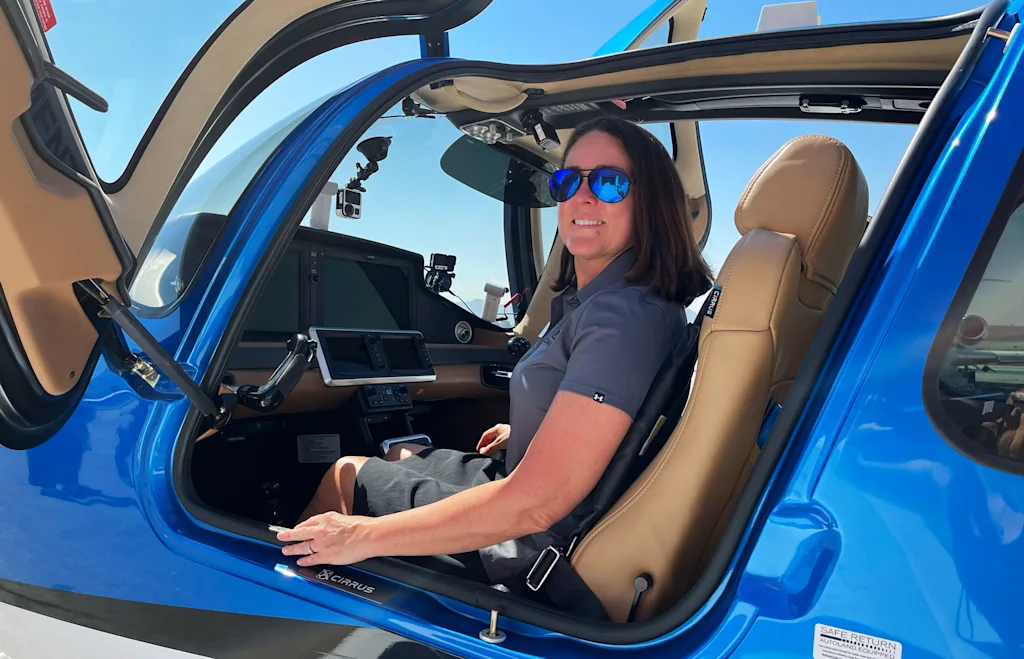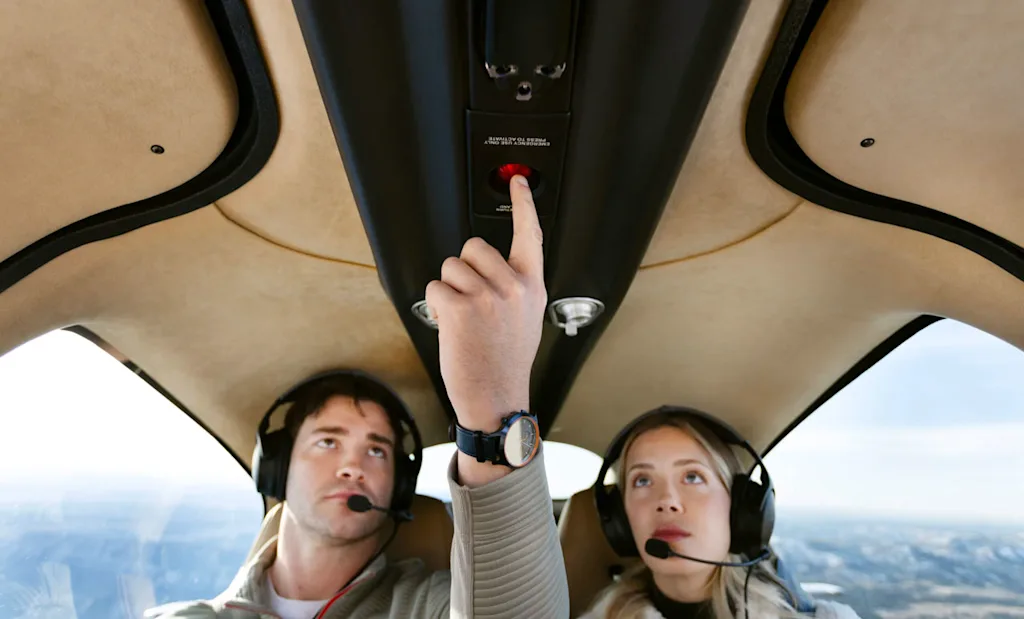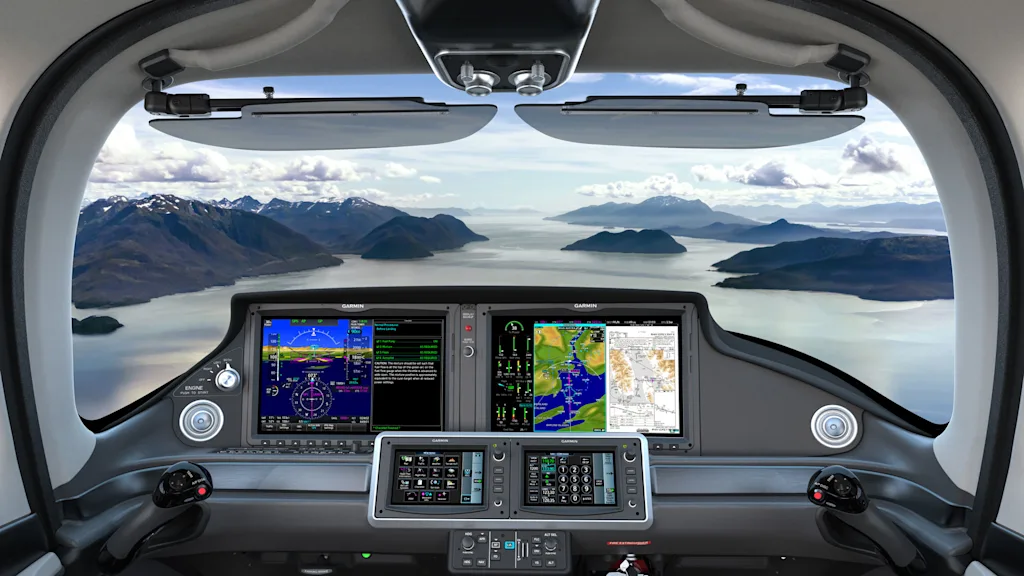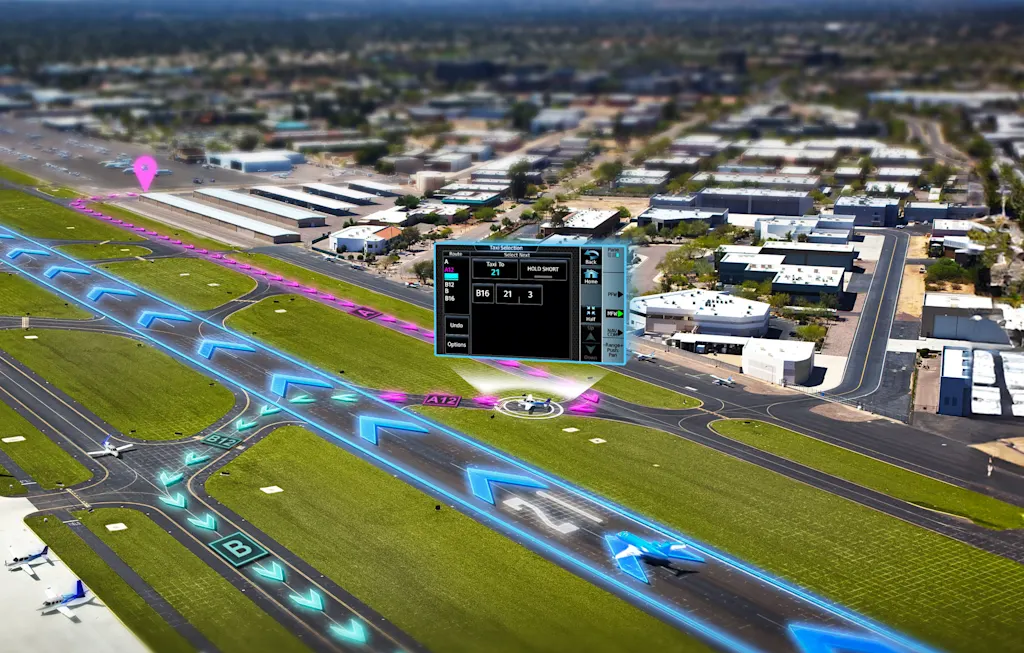A 95°F Los Angeles is much more palatable at 4,500 feet—a 20-minute flight in a sleek new Cirrus Aircraft piston engine four-seater, from the Burbank to Camarillo airports, above a smog-laden urban sprawl that would otherwise take us an hour to drive. Cozy bucket seats, large windows, and large touchscreen control monitors give a modern vibe. It’s a beautiful day to fly—until calamity strikes and the pilot can no longer function. She turns to me, “Okay, when you’re ready . . .”
I half-twist from the front passenger seat and push a large red button in the cabin ceiling in front of the two back seats. Immediately, a recorded female voice calmly announces: “Emergency Autoland activated.” There’s a barely perceptible shift in the plane, which is now stabilized and flying on its own, figuring out where to land. In truth, my pilot, Ivy McIver (call name: “Poison,” for Poison Ivy), is very much alert and demonstrating Safe Return™ Emergency Autoland by Garmin, an emergency system that takes control of the plane in the event of pilot—or pilot and passenger—incapacitation.
Developed by Kansas avionics firm Garmin with considerable input from Cirrus to customize it for its planes, Safe Return is the star feature of Cirrus’s new SR series G7+ aircraft, which rolled out in May to an enthusiastic response.

The Safe Return system already exists on Cirrus’s single-engine jet and turbine turboprop models, and competitors use their own configured versions of Garmin’s Emergency Autoland. But this is the first time any brand has integrated it into a single-engine piston aircraft—the type used by student pilots. Cirrus’s SR series is the world’s best-selling piston engine plane, with over 10,000 sold since 1999.
The goal is to open personal aviation to a broader audience. “We’ve had a lot of people, not in aviation now, say, this gives me the peace of mind to explore getting into aviation, because of this additional safety technology,” says McIver, who is also executive director of the SR product line. “So, we’re keeping more people in and growing aviation at the same time.”

Though it won’t mention specific numbers, Cirrus has already noted a dramatic rise in its SR series order rate, both in the U.S. and abroad, where the craft is licensed to fly. Even budget-conscious flight schools are ready to meet the $674,000 to $1.3 million price tag, depending on model and add-ons. “The flight schools have been like, `This is the reason why I want to get this aircraft, because it gives us peace of mind that our students, if they go up on a solo flight and panic or the weather turns and it’s beyond their capabilities, have a way to bring themselves and the plane back,” she adds.
When activated, Safe Return immediately levels the wings and stabilizes the aircraft at the altitude and direction it had been flying. Even with no one able to press the button, the software—which tracks pilot interactions with the controls—will notice unresponsive flight deck sensors or erratic flying and take over. Conversely, if a passenger mistakenly thinks the pilot is in trouble and hits the button, the pilot can disconnect it.

Pilot incapacitation is mostly caused by medical issues, disorientation due to dangerous weather or visibility, and cabin pressure loss leading to hypoxia (oxygen deficiency) and unconsciousness. Such accidents are considered a subset of pilot error statistics and therefore difficult to tease out, though some estimates have noted three accidents per thousand and .045 and .23 times per 100,000 hours for pilots in their 40s and 60s, respectively.
But Cirrus safety design has as much to do with psychological ease as stats. “Cirrus has always tried to figure out how to get more people into aviation and make people more comfortable with the idea of flying in a small plane,” says McIver. “It was driven by our overall pursuit to make aviation safer and more approachable and comfortable, to grow the number of people participating in personal aviation.”
Our plane is now scouting for the nearest suitable municipal airport to land. (Were this an actual emergency, it would have communicated directly with nearby air traffic control. But as this is a demo flight, McIver is the one talking to ATC.) While the recorded human voice reminds us that the Safe Return system is on, text messages on the seat monitors announce upcoming airplane maneuvers and the time to landing. Passengers are also able to talk directly to ATC.
“If passengers are aware of what’s happening, it gives them a sense of control and comfort,” says McIver.
It’s a point driven home in our flight. “We are going to bank left,” says one text message, moments before the craft tilts left into a full circle that slowly decreases our altitude. Had I not been alerted ahead of time, my heart would have leapt into my throat. Coming out of the loop, the text alerts: “Five minutes to landing” while the throttle handle moves on its own. The wing flaps deploy to slow the plane as it gradually descends into the Camarillo Airport airspace and gently touches down on its runway before coming to a full stop and instructing how to open the doors and exit the craft.
“I haven’t touched the controls this whole time,” says McIver, holding up her hands.
The piston problem
Cirrus introduced Safety Return first to its Vision Jet in 2020, followed by its other digital engine aircraft. But it would take another five years to solve the engineering challenges of integrating it into a piston engine. Safe Return software more easily communicates with computerized engines. Incorporating it into a mechanized piston engine requires an interim layer of technology to translate digital signals into analog movements. The software now interfaces with servos (motion-controlling devices) attached to valve motors and engine linkages that move the engine throttles. As a result, the system must be built into the airplane from the ground up—it can’t be retrofitted.
The system flies the plane, not with AI, but a preprogrammed algorithm that coordinates cloud-updated onboard map databases with the real-time flight data—i.e., altitude, location, fuel, speed, weather, terrain, and nearby runway configurations—to determine the nearest airports with the safest approaches for landing. It will route a course around heavy rain and thunderstorms, and, in cold-enough temperatures, deploy an anti-icing system. In case the plane is unable to fly due to mechanical failure or an empty fuel tank, the system will tell passengers to pull a red lever on the roof and deploy the parachute—a longstanding safety feature on all Cirrus aircraft that’s saved over 265 lives.

After landing, the system gauges runway length to determine how much brake pressure to apply and when to idle the power. “One of the biggest challenges was figuring out how to program the software to control these mechanical features to elegantly control the airplane,” says McIver. “Landing involves a fair amount of pilot finesse, and we’re trying to basically computerize this pilot finesse.”
But don’t expect it to land just anywhere. “It’ll avoid Camp David,” adds McIver. “And Area 51.”
Jelentkezéshez jelentkezzen be
EGYÉB POSTS Ebben a csoportban

Instead of worrying about making friends or keeping up with their studies, new college students have a different concern on their minds: dorm water.
“Praying dorm water doesn’t ruin my h


As demand for artificial intelligence technology boosts

Federal auto safety regulators are investigating why

There’s a new viral chocolate bar on the block.
Angel Hair chocolate, created by Belgian brand Tucho, launched in December 2024 and ticks al

You can now look up skibidi, tradwife, and delulu in the Cambridge Dictionary.
Among the 6,000 or so words added to the dictionary over the past year, these i

